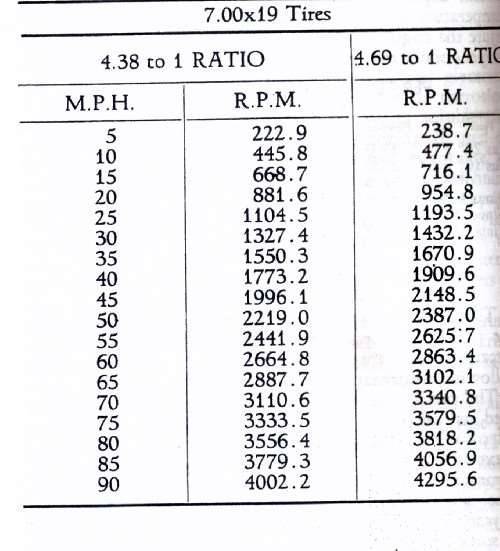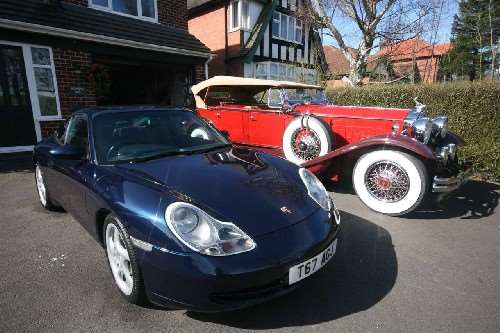|
Increasing top speed
|
||||
|---|---|---|---|---|
|
Home away from home

|
Some advice please.....
I'm a bit concerned about getting an appropriate speed out of my 745. Obviously there's no rev-counter so I dont know what the engine speed is but I am reluctuant to take the car above 40 mph as it does seem to me that the engine is screaming at that speed. The speedo reads about 5mph high (speed check camera local to me confirms my speed is 30mph when the speedo reads 35) The thing is, with the speed of modern traffic I'd like to think I could travel at 50-55 mph (although the others near my home would prefer 90 -100 mph!! Can anyone tell me what revs this engine would be doing at 40mph? Is there a reasonably priced solution for a higher ratio differential or an overdrive or what? Thanks chaps
Posted on: 2012/3/27 2:04
|
|||
|
1930 Deluxe 8 745 Dual Cowl Sport Phaeton
See me in the Registry |
||||
|
||||
|
Re: Increasing top speed
|
||||
|---|---|---|---|---|
|
Home away from home

|
Hello kts68:
You may want to contact: Phil Bray 8858 Ferry Road Grosse Isle, MI 48138 e-mail: carolbray@yahoo.com He has been reproducing high speed rear end gear sets for decades. In his latest ad in the Cormorant News Bulletin he says that he has gear sets for: "Senior Packards 1928 to 1939" "Junior Packards 1937 to 1942 - Sixes and 120s" "120 Packards 1935 to 1936" "Super Eights 1939 to 1942" "Clippers 1941 to 1947" Some friends have installed his gear sets and are happy with the results. Don't ask me for details, I am only reading his ad and questions should be directed to Phil. --Roger--
Posted on: 2012/3/27 7:41
|
|||
|
||||
|
Re: Increasing top speed
|
||||
|---|---|---|---|---|
|
Home away from home

|
Quote:
"Can anyone tell me what revs this engine would be doing at 40mph?" Need to know an actual scaled OVERALL diameter of wheel and tyre (not the tire size printe on tyre). Also need to know rear axle ratio and then rpm can be determined.
Posted on: 2012/3/27 7:45
|
|||
|
VAPOR LOCK demystified: See paragraph SEVEN of PMCC documentaion as listed in post #11 of the following thread:f
packardinfo.com/xoops/html/modules/newbb/viewtopic.php?topic_id=7245 |
||||
|
||||
|
Re: Increasing top speed
|
||||
|---|---|---|---|---|
|
Home away from home

|
Quote:
"The thing is, with the speed of modern traffic I'd like to think I could travel at 50-55 mph (although the others near my home would prefer 90 -100 mph!!" Yes!! This has become a problem for me too with my 48 Indian motorcycle. A problem despite 40 years of trying to make even just a 70 mph interstate hiway cruiser out of it. Nothing worse than becoming a moving road obstacle. And nothing worse for image of vintage tin collectors too. I'm no Packard streight 8 expert by any stretch of imagination. But nearly all prewar engines regardless of make or manufacture were 2500 rpm engines (SAFE SUSTAINED rpm). 2800 rpm on an optimistic starry eyed day looking thru heart shaped rose colored glasses. Regardless of what u do in terms of hi-speed axle gears or overdrives be sure to use tyres that will yield as large an OVERALL diameter of wheel/tyre as possible. Most likely when u get REAL SERIOUS about running 70-80 mph (SUSTAINED) u'll have to drop a modern V8 in it. LImitations are limitations. The very long stroke engines of the prewar era (say over 4 inch stroke) will wear piston rings real fast at rpm levels above 2500 rpm. But as prewar flat head engines thay are rather ez to re-ring at short intervals too. U just have to decide how much money u want to spend, how much time in maintence, how heart set u are on engine originality etc. U WILLL make a COMPROMISE. I promise. OR u'll poke along at 50 mph the rest of your life.
Posted on: 2012/3/27 7:55
|
|||
|
VAPOR LOCK demystified: See paragraph SEVEN of PMCC documentaion as listed in post #11 of the following thread:f
packardinfo.com/xoops/html/modules/newbb/viewtopic.php?topic_id=7245 |
||||
|
||||
|
Re: Increasing top speed
|
||||
|---|---|---|---|---|
|
Home away from home

|
Using Owens chart above it should be possible to interploate engine rpm using ANY axle ratio. KTS, let us know what axle ratios are available from Phil Bray. Then we can determine engine rpm. Also need YOUR ACTUAL SCALED overall measurement of wheel and tyre for a closer calculation if repop tyres vary in diameter from original.
Posted on: 2012/3/27 8:22
|
|||
|
VAPOR LOCK demystified: See paragraph SEVEN of PMCC documentaion as listed in post #11 of the following thread:f
packardinfo.com/xoops/html/modules/newbb/viewtopic.php?topic_id=7245 |
||||
|
||||
|
Re: Increasing top speed
|
||||
|---|---|---|---|---|
|
Home away from home
|
I used the tiny tach to do rpm tune ups, set idle, etc. Could easily run into the cabin to watch while driving, and it's installation is just wrapping around a spark plug wire and grounding the other wire...after that, it's one wire into the cabin. Good investment to see exactly what rpm you're at.
Also, you could just connect an average dwell meter, most have rpm settings, if you wanted to just see temporarily what rpm each, say, 5 mph above 50 is. tinytach.com/tinytach/gasoline.php
Posted on: 2012/3/27 9:08
|
|||
|
||||
|
Re: Increasing top speed
|
||||
|---|---|---|---|---|
|
Home away from home

|
That's all good advice - thank you all.
I think I will invest in a small tachometer - maybe locate it on a swing-bracket so I can pull it down from behind the dash when I want to see it and then push it back out of the way to preserve the original appearance. That little digital type might be perfect. Before I spend money on higher diff gearing, I will check the rpm. Dave's table shows that at 40mph the engine should only be doing 1800rpm. Assuming a safe limit of 2500 rpm, even if that's for short periods, that would equate to 55 mph which would be more than adequate. My problem is as PackardV8 said - I try not to be a rolling road block as folks tends not to have any patience at all these days. Hopefully it might just be a case of my hearing playing tricks on me and the engine might be easily pushed more than I think it can....... mini- tachometer it is I think. I have to confess that the slow speed issues came to a head on Sunday afternoon when I drove the Packard to the pub after having had a spin in my new toy, aquired the day before............
Posted on: 2012/3/27 10:04
|
|||
|
1930 Deluxe 8 745 Dual Cowl Sport Phaeton
See me in the Registry |
||||
|
||||
|
Re: Increasing top speed
|
||||
|---|---|---|---|---|
|
Home away from home

|
Dear Kts68:
Keep in mind that Packard was operating the Proving Grounds when your car was built and so you better believe that the standard axle ratio is going to provide the highest top speed under most driving conditions. Higher ratios do not usually translate into higher top speed and in many cases actually lower it. Now when these cars were new they were capable of taking a lot more stress and would perform pretty well right up to the 4000-4200rpm limit. Today you're not going to be able to cruise with the throttle wide open for long without something going into orbit. Technically speaking, those big headlights are worth about 3 mph each, the spot light 1.5 mph, trippe lights another 4 miles per hour and the windshield another 4-5 mph. These figures are estimated from tests made by state police departments of top speed reductions from light bars, spot lamps, and other bolt on accessories. I've driven Packard Speedsters and they really do go. You start rolling along at 55 mph and everything is great. But after a while the darn thing is creeping up to 65 mph and you don't even know it. However, the next question is how to stop the darn thing. Those cars were built when there were 95% fewer cars on the road. Hope this helps.
Posted on: 2012/3/27 18:45
|
|||
|
||||
|
Re: Increasing top speed
|
||||
|---|---|---|---|---|
|
Home away from home
|
If it was me, I would like to have the final drive ratio bring the engine speed to its peak torque rating at the desired cruising speed. This way I would always be on the power producing part of the curve. As my friend Denise McLuggage once said to me: "My daddy said, it's all about torque and range."
(o[]o)
Posted on: 2012/3/27 22:05
|
|||
|
We move toward
And make happen What occupies our mind... (W. Scherer) |
||||
|
||||


 (100.60 KB)
(100.60 KB)







